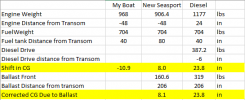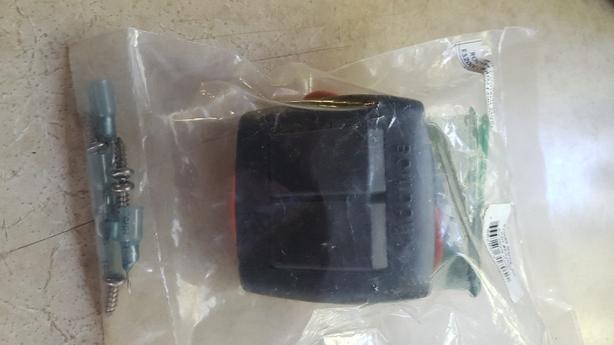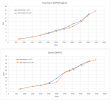Captain PartyMarty
Crew Member
I hear ya guy's and thanks for the offer Ship Happen. I am going to move the engines up first in the next week or so. I will definitely test a four blade.
By podding you have adversely affect the vessel fore-aft center of gravity & your symptoms fit. The value used to calculate this is "foot pounds"; if you move 600 pounds of engines/brackets to the rear by 3 feet you have affected the COG by 1800 foot pounds This is an example & your actual weight/distance values may differ. There is good reason the boat mfgr placed the fuel tanks more forward on the podded boats. If your boat is 25 feet long, the fore-aft COG should be about 1/3 distance from the stern; let's say 8 feet from the stern. Using the above values, around 150 lb in the bow SHOULD restore the proper COG but with weight being at the extreme ends of the boat instead of where it should be (more towards the fore-aft center), the boat will never perform ideally.
Yes to both however I am only aware of the issues & math involved; I have owned 2 podded boats, so my experience is very limited. Also, trading an I/O for a podded O/B greatly reduces the overall boat weight which gets more hull out of the water (seems to be a very good thing). Did a 24 Searay back in 1989; chevy V8 to Yamaha 250; no there changes needed & back then I wass too young & stupid to know any better; the shop had some experience in this area plus the pod mfgr (armstrong) was familiar with podding a 24 Searay. But if you do the math on the above example it is pretty good. The other issue is how well balanced a boat is from the factory before modifications. I am sure they all do some math, but how many do the math, test/tweak versus "close enough works for me"? I tried to find info on what stability tests the CG requires but struck-out.So if 150lbs in the bow isn't possible due to structural design, but there is room for additional ballast closer to the original cog, is it straight line math to increase the blast weight required? Or are you suggesting that some boats are simply not candidates for a pod installation due to design limitations? Thx
What does the CC weigh? Sounds cool. I'm seriously considering this. Or just buying a new boat. The Commander has the same issues. Designed for gassers so sits butt heavy with the diesels.Yes to both however I am only aware of the issues & math involved; I have owned 2 podded boats, so my experience is very limited. Also, trading an I/O for a podded O/B greatly reduces the overall boat weight which gets more hull out of the water (seems to be a very good thing). Did a 24 Searay back in 1989; chevy V8 to Yamaha 250; no there changes needed & back then I wass too young & stupid to know any better; the shop had some experience in this area plus the pod mfgr (armstrong) was familiar with podding a 24 Searay. But if you do the math on the above example it is pretty good. The other issue is how well balanced a boat is from the factory before modifications. I am sure they all do some math, but how many do the math, test/tweak versus "close enough works for me"? I tried to find info on what stability tests the CG requires but struck-out.
Most recent is swapping twin IB Diesels amidship for 2 300 etec's on a 33 ft Chris Craft. Moved the fuel tanks forward about 8 feet. Boat was originally twin Chevy V8's so when podded was already about 600 - 700 pounds overweight with the diesels. Very little experience with sea trials as I installed a new dash panel/extensive re-wire, but the boat sits 3-4 inches higher & the angle it sits at in the water look good. Need a run to WCVI (from Everett WA) to fully evaluate. Went from steel to AL fuel tanks; overall I am probably 1200 lb or so lighter.
Before the last project I joined boatdiesel.com to use their prop calculator to model weight, horsepower & prop changes to predict performance.
Adding weight reduces MPG & speed so going with little/ no ballast is preferable.
Before the mod's I guessed at 15K lb. You are I/O with 6 cylinder Volvo's right? My pod is 4 feet long from the stern, & you would loose 800 or so pounds but 6 or so feet farther back. Boat goes 40 MPH with rough bottom paint & with direct injection I get 8mpg at hull speed. You COULD loose that weight by going with Volvo D3's. The conversion was VERY expensive & since my wife is not a forum member I will admit to around $80K US including $30K for used engines. With I/O you have many fewer holes to plug-up & the transom may not need re-enforcing.What does the CC weigh? Sounds cool. I'm seriously considering this. Or just buying a new boat. The Commander has the same issues. Designed for gassers so sits butt heavy with the diesels.
I would never consider a diesel IO again.Before the mod's I guessed at 15K lb. You are I/O with 6 cylinder Volvo's right? My pod is 4 feet long from the stern, & you would loose 800 or so pounds but 6 or so feet farther back. Boat goes 40 MPH with rough bottom paint & with direct injection I get 8mpg at hull speed. You COULD loose that weight by going with Volvo D3's. The conversion was VERY expensive & since my wife is not a forum member I will admit to around $80K US including $30K for used engines. With I/O you have many fewer holes to plug-up & the transom may not need re-enforcing.
My main issue was the shops in my area that do diesels are total A-holes plus low maintenance of O/B power. My surveyor & a repair guy from a diesel shop both told be O/B's were the best choice. Having the props 6 feet back from the stern will be a bit of a pain for DR fishing.
Makes me feel better about the $80K; thanks. Plus the emissions are a huge issue; I want to take the grandkid's & sleep at night.I would never consider a diesel IO again.
Well I don't know if I want to claim that prize necessarily but I would like to make an informed decision. It's just too bad you're team black or team white these days. There's a huge area in the middle to be a part of that unfortunately doesn't get you any pats on the back.BTW nice job on bucking the vocal minority on the Mark Selective Fishery stuff; thanks. I am a retired Computer Consultant & witnessed great amounts of "cherry picking" facts; seems like just about everybody does it these days.
By podding you have adversely affect the vessel fore-aft center of gravity & your symptoms fit. The value used to calculate this is "foot pounds"; if you move 600 pounds of engines/brackets to the rear by 3 feet you have affected the COG by 1800 foot pounds This is an example & your actual weight/distance values may differ. There is good reason the boat mfgr placed the fuel tanks more forward on the podded boats. If your boat is 25 feet long, the fore-aft COG should be about 1/3 distance from the stern; let's say 8 feet from the stern. Using the above values, around 150 lb in the bow SHOULD restore the proper COG but with weight being at the extreme ends of the boat instead of where it should be (more towards the fore-aft center), the boat will never perform ideally.

The big thing is moving the fuel tank amidships. We set my 450 L tank amidships as well and the boat is beautifully balancedMy boat was poded by someone who must have know what they were doing and we do not have a problem with COG having been shifted back. The big 6cyl 225 Opti is a lot lighter than the original inboard-outboard. Further the pod is the large hull forming floatation type which correctly counters the weight of the motor on the pod. I was told some lead has been added into the pod to counter act some of the floation which can be removed if the light two stroke outboard were to be replaced with a heavier 4 stroke outboard. In addition the outboard has a stainless 4 blade prop which adds a degree of stern lift on plane. The large fuel tank is mid ship and slightly forward on the boat and long and narrow along the keel line. I top up the fuel tank frequently and try to not to let it it get below 60% full which adds ballast low down and forward on the boat. With this set up the boat jumps onto plane and the bow comes down quickly and the boat naturally sits flat on the water, both at speed and going slow.

 www.usedvictoria.com
www.usedvictoria.com

4 blade is the way to go, once you get the pitch tune in you will love themFinally managed to get out and test the 4 Blade today. Here are the plotted results of the 4 blade and the 3 blade under the same conditions. I would consider the loading light with approximately 50% fuel and 2 People On-board.
View attachment 66773
Observations from my side.
1) I need to move up 1 or two Pitch sizes on the 4 Blade As I was able to go over the 5400 RPM limit for the SeaPro's. I hit 5520 rpm and It didn't feel like it was done there I backed off pretty quickly.
2) The 4 blade does fix a lot of issues, The boat didn't porpoise at all and so I didn't need to use any trim tab to control the boat
3) As shown in plot 2 I was on plane at much lower speed with the 4 blade.
4) The boat overall handled much nicer with the 4 blades.
Next Steps
1) See of I can get an 18P Revolution 4 prop setup
2) Move the engines up 1 hole.
